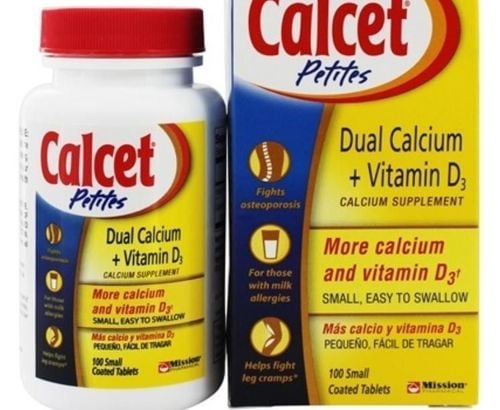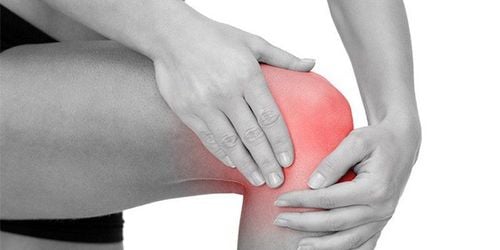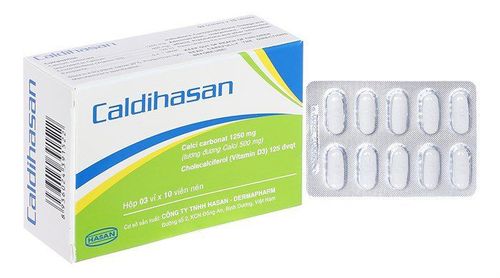This is an automatically translated article.
Alenocal is a medicine containing Alendronic Acid and Vitamin D3 that helps to solve the problems of osteoporosis in women and men aged 45-60 years. To ensure the effectiveness of using Alenocal, users need to follow the instructions of their doctors, and refer to more information about the uses of Alenocal in the following article.
1. What are the effects of Alenocal?
1.1. What is Alenocal? Alenocal belongs to the group of analgesics, antipyretics, non-steroidal anti-inflammatory drugs, treating Gout and osteoarthritis. The drug has registration number VD-26438-17, manufactured by SPM Joint Stock Company - Vietnam.
Alenocal drug contains the main active ingredients:
Alendronic acid (in the form of Alendronate sodium trihydrate) content 70mg; Vitamin D3 (cholecalciferol) (equivalent to 2800IU) content 70mcg The drug is prepared in the form of blister tablets of 4 tablets, box of 1 blister.
Alenocal is a prescription drug (ETC), recommended for use in adults. Patients absolutely do not buy medicine at home without the permission of the doctor.
1.2. What does Alenocal do? Alendronate sodium is a bisphosphonate that acts as a potent specific inhibitor of osteoclast-mediated bone resorption.
Cholecalciferol (Vitamin D3) is required for normal bone formation. Vitamin D deficiency increases when the person is not exposed to regular sunlight and lacks nutritional supplements. Vitamin D deficiency is associated with calcium imbalances, bone loss, and an increased risk of fractures. In severe cases, vitamin D deficiency will cause secondary hyperparathyroidism, hypophosphatemia, weakness of tendon attachment points, osteomalacia, in addition to increased risk of falls and fractures in people with osteoporosis .
Alenocal is a combination of the 2 above compounds indicated for use in the following cases:
Osteoporosis in postmenopausal women: Helps prevent fractures, including vertebral fractures (spinal depression). , hip fractures and ensuring adequate vitamin D intake. Osteoporosis in men: To help prevent fractures and to help ensure adequate vitamin D. Alenocal is contraindicated in cases of:
Patients allergic to ingredients Alendronate sodium itself, Cholecalciferol or any of its ingredients. Abnormalities such as narrowing or loss of elasticity of the esophagus lead to delayed esophageal emptying. Inability to sit upright or stand upright for at least 30 minutes. Decreased blood calcium index.
2. Usage of Alenocal
2.1. How to take Alenocal Alenocal is taken orally. Take Alenocal at least 30 minutes before eating. Patients should take the medication with a full glass of water to make it easier to get the medicine into the stomach and to reduce the potential for irritation or other side effects in the esophagus. It should be taken in the morning and after taking it, do not lie down for at least 30 minutes. Other beverages (including mineral water), food, and certain other medications can decrease the absorption of Alenocal. Do not take the medicine before going to bed or lying in bed when you wake up. Failure to follow these instructions increases the risk of adverse effects on the esophagus. 2.2. Dosage of Alenocal The recommended dose is 1 tablet per week. Patients need supplemental calcium and/or vitamin D, if the amount provided in the daily diet is not enough. Doctors also need to consider the amount of vitamin D in vitamins or nutritional supplements to get the right dosage. Based on a daily vitamin D dose of 800 units. No dose adjustment of Alenocal is required for the elderly or in patients with mild to moderate renal impairment (with creatinine clearance between 35 and 60 mL/min). Alenocal is not recommended for patients with more severe renal impairment (with creatinine clearance less than 35 mL/min) because there is no clinical experience in these subjects. Dealing with missed doses:Alenocal is only taken once a week, so it's easy to forget to take it. Drink as soon as you remember, but still need to follow the instructions for taking the medicine. Try to remember or set an alarm to take your medicine at the right time. Treatment of overdose:
Alendronate sodium:
Symptoms: Taking an overdose of the drug can cause hypophosphatemia, hypocalcemia, and unwanted effects in the upper gastrointestinal tract such as heartburn, digestive disorders. , esophagitis and inflammation or ulceration of the stomach. Management: Give the patient milk or antacids to combine with Alenocal. Due to the risk of esophageal irritation, the patient should be fully upright and should not induce vomiting. Cholecalciferol:
Toxicity of vitamin D when given orally for long periods of time in healthy adults has not been observed in healthy adults at doses <10,000 IU/day. In a clinical study report in healthy adults, with a daily dose of 4000 IU of vitamin D3 for a period of 5 months, no hypercalciuria or hypercalcaemia was observed.
3. Notes when using Alenocal
Alenocal may cause local irritation of the upper gastrointestinal mucosa. Esophageal adverse reactions, such as esophageal ulceration, esophagitis, and erosive esophagitis, have rarely resulted in esophageal stricture or perforation in patients treated with Alenocal. Some severe cases require hospitalization. Therefore, if you find it difficult to swallow, painful swallowing, heartburn, new or worsening retrosternal pain, you must stop taking the drug and notify your doctor immediately. The risk of serious adverse reactions to the esophagus is greater if the patient lies down immediately after taking the medicine or does not take the medicine with a full glass of water or continues to take the medicine despite the symptoms of suspected irritation. Esophageal. Alenocal should be used with caution in patients with upper gastrointestinal tract problems, such as esophageal diseases, dysphagia, inflammation or ulcers of the stomach and duodenum. Patients taking bisphosphonates (including Alenocal sometimes experience bone, joint or muscle pain). These symptoms are rarely severe or disabling. The time to onset of these symptoms ranged from one day to several months after starting the medication. Most patients experience relief of symptoms after discontinuing the drug. Causes of osteoporosis other than advanced age, estrogen deficiency, and glucocorticoid use should be considered at diagnosis. In patients with hypocalcaemia, aggressive treatment of other disorders affecting mineral metabolism (eg, vitamin D deficiency) is required. In patients with these disorders, serum calcium levels and symptoms of hypocalcemia should be monitored during treatment with Alenocal. The Vitamin D3 component in Alenocal may increase the level of hypercalcaemia or hypercalciuria when used in people with conditions associated with excessive amounts of calcitriol that the body cannot regulate on its own (e.g.: lymphoma, leukemia, sarcoidosis). In these patients, calcium concentrations in urine and serum should be regularly monitored. Patients with malabsorption may not be able to fully absorb vitamin D3.
4. Side effects of the drug Alenocal
During the use of Alenocal, patients may still experience side effects such as:
Body as a whole: Urticaria, angioedema, acute phase (difficulty, weakness, myalgia and rarely fever) and hypothermia. blood calcium. Gastroin- . Localized osteonecrosis of the jaw, often associated with tooth extraction or local and long-lasting infection. Musculoskeletal: Bone-joint-muscle pain, rarely severe or disabling, upper femur fracture due to mild impact and joint swelling. Nervous system: Taste disturbance, dizziness and vertigo,. Skin: Rash (sometimes with photosensitivity), pruritus, serious skin reactions such as toxic epidermal necrolysis and Stevens Johnson syndrome. Special Senses: Scleritis, sclerosing choroiditis, or inflammation of the sclera. If you experience these symptoms, the patient should stop using Alenocal and notify the doctor for appropriate treatment.
5. Alenocal drug interactions
If Alenocal is taken at the same time with antacids and other oral drugs, it will affect the absorption of the active ingredient alendronate. Therefore, patients must wait at least half an hour after taking Alenocal before taking other medicines. Concomitant administration of Alenocal with hormone replacement (HRT) drugs (estrogen ± progestin) and drugs containing the active ingredient alendronate sodium has been clinically shown to increase bone mass and reduce bone degeneration, compared with with individual drug use. Co-administration of Alenocal with mineral oils, olestra, orlistat, bile acid binding agents (eg, colestipol, cholestyramine) may interfere with vitamin D absorption. Anticonvulsants, thiazide diuretics , cimetidine may increase the catabolism of vitamin D.
6. How to store Alenocal
Alenocal shelf life is 36 months from the date of manufacture. The drug is stored at room temperature below 30 degrees Celsius, in a cool and dry place, avoiding direct sunlight. Do not store Alenocal in places with high humidity such as bathrooms, refrigerators. Keep Alenocal out of reach of children. Above is all information about Alenocal drug, patients need to carefully read the instructions for use, consult a doctor / pharmacist before use. Note, Alenocal is a prescription drug, patients absolutely must not buy drugs to treat at home because they may experience unwanted side effects.













